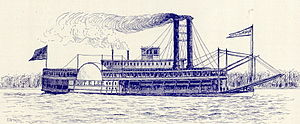 Robert E. Lee, drawing by Samuel Ward Stanton (1870–1912)
| |
| History | |
|---|---|
| Owner | Capt. John W. Cannon[1] |
| Route | Mississippi River |
| Cost | More than $200,000 |
| Launched | 1866, at New Albany, Indiana |
| In service | 1866 |
| Out of service | 1876 |
| Fate | Dismantled, equipments moved to the second Robert E Lee (1876–1882) |
| General characteristics | |
| Type | inland steamboat |
| Tonnage | 1467 |
| Length | 285.5 ft (87.02 m) |
| Beam | 46 ft (14.02 m) |
| Installed power | twin high-pressure steam engines; cylinder bores 40 inches (101.6 cm); stroke 120 inches (304.8 cm); eight iron boilers each 46 feet (14.02 m) long and 27 inches (68.6 cm) diameter, working steam pressure 120 lbs.[1] |
| Propulsion | sidewheel |
| Speed | 15 Mph |
Robert E. Lee, nicknamed the "Monarch of the Mississippi," was a steamboat built in New Albany, Indiana, in 1866 (Not to be confused with the second 1876–1882 and third 1897–1904 Robert E Lee). The hull was designed by DeWitt Hill, and the riverboat cost more than $200,000 to build.[2] She was named for General Robert E. Lee, General in Chief of the Armies of the Confederate States. The steamboat gained its greatest fame for racing and beating the then-current speed record holder, Natchez, in an 1870 steamboat race.[3][4]
- ^ a b Stanton, Samuel Ward, American Steam Vessels, New York, Smith and Stanton 1895, page 197.
- ^ The Drawings of the Mississippi River Steamer 'ROBERT E. LEE'
- ^ The Riverboats Natchez
- ^ Natchez Under The Hill Saloon – Natchez Mississippi